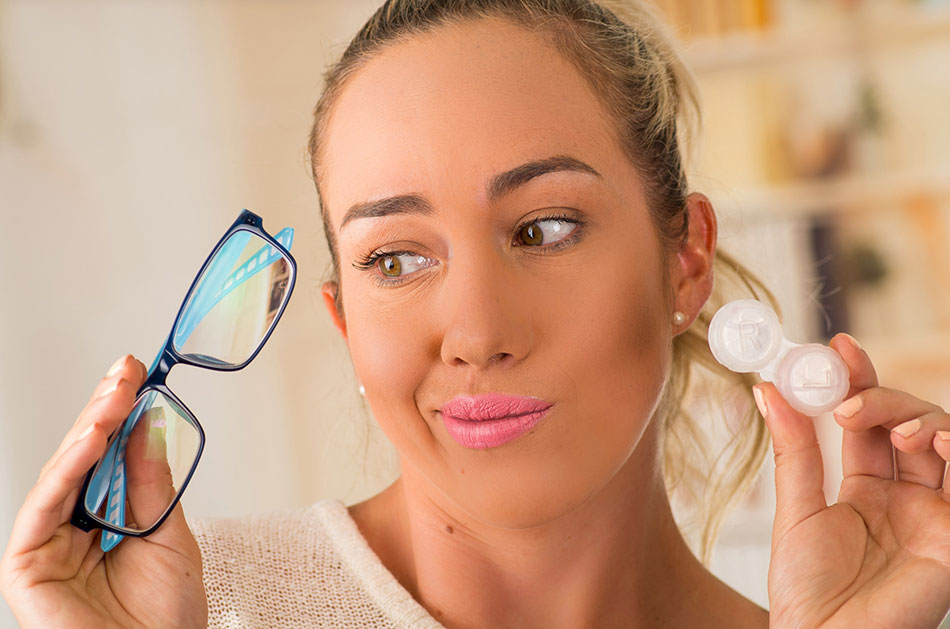Wearing Contacts With Astigmatism: Your Questions Answered

Nearly one in three people in the United States have astigmatism, which is caused by an irregularly shaped cornea. Many of these people also experience near or farsightedness as well. So if you wear glasses, you may have astigmatism too.
In the past, people with astigmatism were often told to avoid contact lenses because older lens designs could not match the shape of the cornea. Fortunately, today’s contacts are far more advanced. Whether you have mild or severe astigmatism, there are options available that can provide clear vision and comfort.
In this guide, we answer common questions about wearing contacts with astigmatism, the types of lenses available, and what to expect when being fitted.
Why Did the Eye Doctor Tell Me I Can't Wear Contacts?

Astigmatism changes the shape of the cornea, making it less round and more like a football. Standard contacts are designed for round corneas, so they do not sit correctly on an astigmatic eye.
- With normal contact lenses, the fit may be unstable.
- Improper fit means the lens cannot move with the eye, reducing visual clarity.
- This is why many eye doctors used to recommend glasses instead of contacts.
The good news is that specialized lenses are now available to address these challenges.
What Kind of Contacts Can I Wear With Astigmatism?
The contacts an ophthalmologist prescribes depends on the type of astigmatism you have. This may be light or strong astigmatism. You have light astigmatism with a prescription of under 1.00 diopter. If your prescription is 1.00 to 2.00 diopters, then you have moderate astigmatism. 2.00 to 3.00 is considered severe. Should you have anything over 3.00 diopters, then you have extreme astigmatism.
Contacts for Light Astigmatism
If your astigmatism is mild (less than 1.00 diopter), rigid gas permeable lenses (GP contacts) may be recommended.
- GP lenses allow oxygen to pass through for healthier corneas.
- They are more durable and provide crisp vision.
- Modern versions use silicone, which improves comfort and oxygen flow compared to older designs.
Contacts for Strong Astigmatism
You can also choose lenses that correct more extreme astigmatism. While standard lenses have a round shape, like a beach ball slice, toric lenses take on a different geometric shape. The toric shape looks much like a donut slice, so they are the best contacts to fit for astigmatism. They have a slightly weighted edge to help them remain aligned with the 6 to 12 o'clock axis on your eye. Blinking helps them rotate and the weight keeps the contact aligned properly.
Toric lenses typically come in dailies or disposable lenses, but the range is growing. You might even find a colored contact lens that fits your prescription.
Is Wearing Contacts With Astigmatism Uncomfortable?
The earliest lens types focused on hard lenses because they performed better than soft lenses. New soft lenses can now provide great comfort and performance, whereas hard contact lenses tend to be less comfortable. However, GP lenses do provide crisper vision than soft toric lenses.
There may be a period of adjustment when you first start wearing your contacts. This is true whether or not you have astigmatism. Over time, however, you should get used to them and feel comfortable wearing them. Ask an eye care professional about different types of GP and toric lenses to find a brand that feels most comfortable to you.
How Are Contacts Fitted for Astigmatism?

Choosing the correct lenses and finding the right fit is critical for finding success with contacts. During discussions with your eye doctor, you may be presented with several options. The goal being, to provide you with the right lenses for both your eye shape and vision.
It's possible that you may need to try different contacts to find the right fit. Toric lenses feature a specific orientation, and they need to stay in place to function properly. Contacts manufacturers add features to help achieve this, including:
- Ballasting (thicker or heavier lenses)
- Lens truncation (removing part of the bottom of the lens)
- Thin and thick zones
Because different manufacturers use their own methods, you may find that the fit of each type differs. The fit is important because if they slip rather than move with your eye, your visual acuity suffers.
If your contacts aren't working, return to your eye doctor to check the fit. Dry eyes may be a problem for those with astigmatism, and dry contacts may rotate out of proper alignment. You may find you need a different multi-purpose lens solution or eye drop to help. Consult your eye doctor before changing brands or types.
You Can Wear Contacts With Astigmatism

With so many people in the U.S. who have astigmatism, contact lenses were bound to be developed for them! You don’t have to let astigmatism prevent you from wearing contacts, but you may spend more time finding contacts that fit and feel good. Make an appointment to talk to your eye care professional about wearing contacts with astigmatism to find out what’s right for you. In the meantime, find out the answers to your burning questions about transitioning to contacts.
FAQs: Wearing Contacts With Astigmatism
Can people with astigmatism wear contact lenses?
Yes. Specialized lenses such as toric contacts and rigid gas permeable lenses are designed to correct astigmatism.
What are the best contacts for astigmatism?
Toric lenses are the most common choice for moderate to severe astigmatism, while gas permeable lenses often work best for mild astigmatism.
Are contacts for astigmatism uncomfortable?
Newer designs are much more comfortable than older hard lenses. While GP lenses provide sharper vision, soft toric lenses are usually easier to adapt to.
How are toric contacts different from regular contacts?
Toric lenses have a special shape and weighted edge that keep them aligned with the eye’s natural axis, ensuring clear vision.
Do astigmatism contacts cost more?
Yes, they are usually more expensive than standard lenses because of their specialized design, but many options are available to fit different budgets.
